Strafser signature and negative text. “SEPT 1880” top center until 1974.
First popular Union stamp issue.
Strafser signature and negative text. “SEPT 1880” top center until 1974.
First popular Union stamp issue.

Dating “Union-Made” Labels
National Cigar History Museum Exclusive
© Tony Hyman, 2017
121916
Founded in 1864, the Cigar Maker’s International Union is one of history’s most influential. Among its many contributions is the national label to identify Union made goods. Adopted at the 1880 convention, the label is blue as a compromise between San Francisco which issued an anti-Chinese white label in 1874 and St. Louis which issued a red label during a strike against a wage reduction in 1875.
The Union label was furnished free to all strictly Union shops, to be placed on cigars made by Union members. If the manufacturer also bought and resold Chinese, tenement house, or scab cigars, it was up to the Local Union to decide whether to withhold the label. If the label is granted to such a firm, it may not be placed on any of the disapproved Chinese, scab or tenement house cigars. It was forbidden to use the label in any factory which paid less than $6 per thousand to its rollers, or on any cigars sold for less than $20 per thousand (2¢ each). No factory who offered any premium as an inducement for the sale of his goods could legally use the label. One of the more controversial, some say short-sighted, decisions by the C.M.I.U. prohibited the blue label to be used on cigars made in whole or in part by machinery (which at first included moulds). Although this dictum was modified later, it prevented bringing the huge new female work-force into the Union expeditiously, causing a substantial loss of momentum in the Union movement.
Because the label underwent frequent changes, it can be an outstanding tool for dating cigar boxes more precisely than is possible with US tax stamps. Some caution is suggested, however, as these “Blue Labels” were not legally regulated by the government or the Union so older issues were sometimes used for a year or two after new ones were available.
Local Union Cancellations
Union Label Placement
photo coming
Stogie Makers Union and others
1915-1926:
G.W. Perkins began signing a Union Stogie Makers stamp in 1915 after the merger of the C.M.I.U. and previously independent Stogie Makers. The photo (left) is of a 30 year old xerox copy of this very rare stamp.
1927-1935:
Starting in 1927, they were signed by I.M. Ornburn. It’s very unusual for a tax stamp to be pasted on top of the Union label.
1936-1944:
R.E. Van Horn signed the reworded stamps during his administration. The Illustration is a photocopy. The NCM does not own an example of this.
1948-1952:
Mario Azpeitia presided over the terminally weakened Union from 1948 to 1974. He signed a simplified form of Union Label used by the Stogie Makers in the very early 1950s.
1952-1974:
Like post 1952 Cigar Makers’ stamps, later Stogie stamps are unsigned and make reference to the A.F. of L.
Stamp courtesy of Brian Roberts, not in the NCM collection.
Stogie Union label/stamps are scarce from any period as stogie makers were few and seldom unionized.
Stamps, stickers and labels have been found for a half dozen other stogie, cigar and tobacco worker unions, but none were used as often and as long as CMIU Blue Labels, and aren’t especially useful for dating.
I haven’t studied the life spans of the various unions to attempt to date them as the time/benefit ratio isn’t there. Happy to hear from folks who have dates of organization and
stamp use for any and all tobacco,
cigar or cigarette Unions.
Tony Hyman
1909 - 19??
Stamp issued by the Universal Cigar Makers and Packers Union, about which the Oct. 15, 1909, CMIU’s Official Journal wrote:
“On June the fifth, 1909, there came into existence in Hanover, PA, a freak, so-called organization...A few disgruntled, suspended, and expelled members of the CMIU of A, coupled with the assistance of several unscrupulous manu-facturers is what this fake affair is composed of...The President, F.J. Sneeringer, is a manufacturer who at one time had the use of a genuine [Union} label; but through repeated violations of the laws governing the use of same forfeited it... Among his small number of dreamers whom he is scheming to use are several who were fined and expelled for working under the bill and general crooked work. One object is to sell their output to unfair dealers who will surely purchase for there is no limit to the selling price [CMIU members were then forbidden to make cigars wholesaling for less than 3¢...th]; neither is there any law covering the amount of hours of labor...at present less than 25 cigarmakers are employed under its banner...” The stamp is close to the CMIU stamp in size, intended to be pasted in such a way that the red seal would be hidden under the box. The stamps were also issued in pink, with a b/w seal, and slightly different wording. Stamp illustration courtesy of Brian Roberts; original not in the NCM.
An inglorious end to America’s best known Union symbol
1952 - 1974
In 1952, the membership approved this printed-on-the-box CMIU label replacement for stamps, as seen on this 1960’s JUDGES CAVE. The diamond is also found elongated side to side.
A pathetic ending for a glorious emblem, tho in keeping with the ignominious demise of the once proud and influential union itself, absorbed into the grocery clerks.
The craftsmen of the 1880’s silently turned over in their graves.
1927-1935:
Same text and 1880 date; Printer’s Union bug moved to new location. Signed I.M. Ornburn, new president. Many sizes, with 3.5” a new standard.
Letter in front of number in Series F.
1936-1944:
A new design was signed by R.E. Van Horn. Capital letters in text replaced; local cancellation area now copyright infringement warning; printers Union bug moved again.
1944-1948:
Same design and text but now signed by A.P. Bower, President. CMIU effec-tiveness severely declined. Note slow rise in serial numbers. Most stamps are 3.5” long.
1948-1952:
Same design and text but now signed by Mario Azpieta. Serial numbers no longer used. The stamp seen here was 3.5” long, used 1951.
1952-1974:
In 1952 the design was changed to an unsigned simplified stamp, a major departure from the wordy past. This is the last of the once proud Blue Label. These were used concurrently with the union bug printed on the box.
George W. Perkins takes over CMIU.
He disliked this negative coolie text,
making this a scarce stamp.
SEPT 1880 stays top center.
1894-1898:
Perkins signature with new positive MORAL, MATERIAL and INTELLECTUAL WELFARE text.
Printer’s Union bug.
1898-1905:
Same as previous issue except Printer’s Union bug made larger.
The most-often-seen CMIU stamp. Widely used.
1905-1908:
Same as previous, but in 1905,
red serial numbers over-printed. Series A 1905 to 1908.
1908-1912:
Series B used 1908-1912.
1912-1916:
Series C used 1912-1916.
1916-1920
Series D used 1916-1920.
[12091]
1920-1926
Series E began in 1920 and used as long as Perkins was in office (1926). Optional smaller size introduced.
First issue: A. Strasser (Strafser) signature, negative text: “COOLY, PRISON, FILTHY TENEMENT HOUSE.”
No date or box size at top center.
No place for Local stamp. 5.5” long.
Some ‘copyrighted’ LowerLeft.
1886:
Short lived experimental issue. Strafser signature, no text. Top center of stamp indicates either 50 or 100 cigars in the box. Rare. Came in two sizes.
1886-1888:
Strafser signature and text. 50-Box or 100-Box at top center with 100 stamps a larger size. Place for cancellation by the local union added at right. COOLY changed to COOLIE.

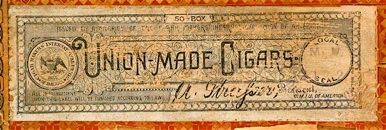


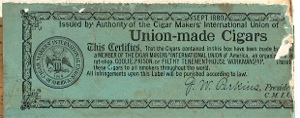






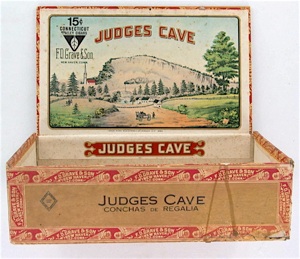
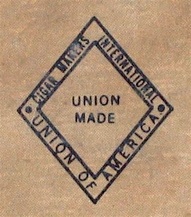
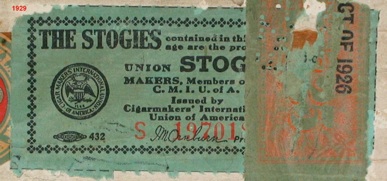
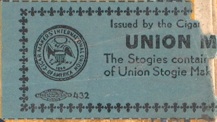
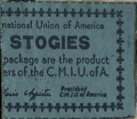
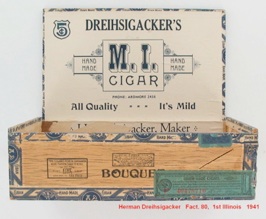
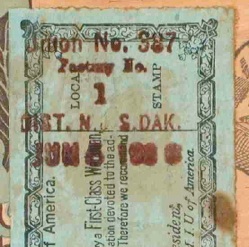
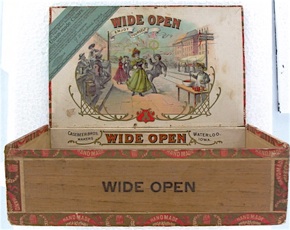
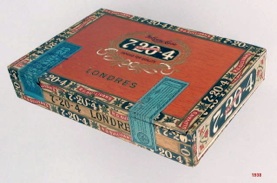
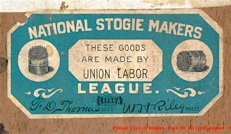
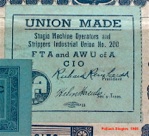
Two short lived CMIU stamps issued by San Francisco local 228 as part of their anti-Chinese campaign. The lower, blue, stamp is known to have been produced in different denomina- tions (25, 50 and 100) and has been found on a box of California cigars from that period. The top version is known only from a poster, though it appears to be multi-denominational.
Top seen courtesy of Brian Roberts.
Lower two seen courtesy of Hermann Ivester. Sadly, neither stamp is found loose in the NCM collection.


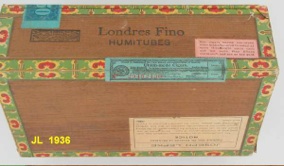
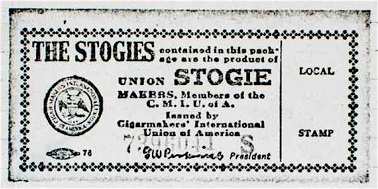
Knights of Labor (K of L)
At first, in 1884, The K of L
tried to use an ‘all trades’ label
but the experiment was short
lived and they began issuing
single-trade stickers like this.
Ironically, the cigar brand
KNIGHTS OF LABOR has the
rare experimental C.M.I.U.
label of 1886, not this one.
[0284] [6551]
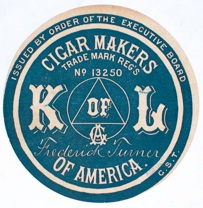
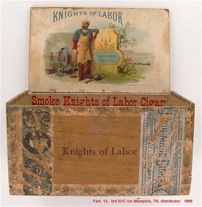
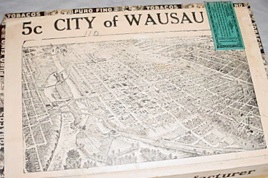
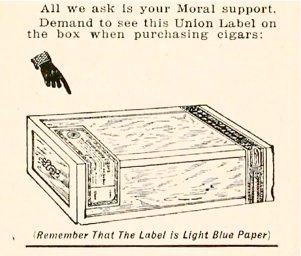
Until the 1930’s, Union Locals were supposed to cancel their “Blue Label” stamps, indicating the Union Local number, the cigar factory’s Federal ID, and the date. Many different shapes and styles of cancellation are seen. Dates, when readable, can be an important clue to the date of a box.
Evidence on boxes suggests locals usually followed the rule, but cancellations were seldom carefully done, so are frequently unreadable.
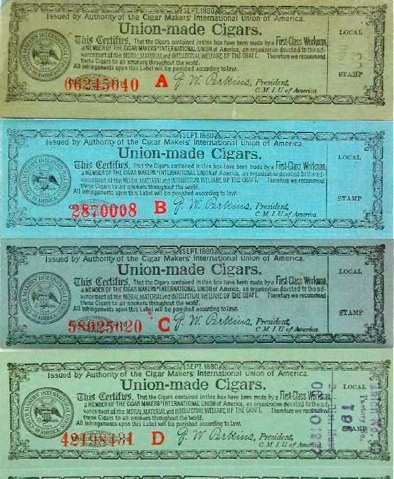
Sizes of C.M.I.U of A. Stamps
Starting in 1915, other sizes of CMIU stamps were permitted. Some, after 1921, were as small as 1 9/16” long.
Overprints on these smaller stamps do not always continue the letter sequencing started in 1905. Presidential signatures on the stamps is a more reliable indicator of date.
[12093]




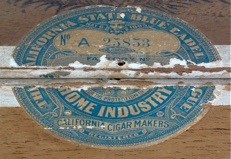
Standard placement of CMIU labels was similar to that of tax stamps, usually on the opposite side of the box. This, in my opinion, was adequate for identifying Union cigars in closed boxes, but no Union identification was visible when the box was open in a crowded cigar counter. The placement on M.I. is no improvement.
Not all states and towns supported Unionism, so discretion was apparently typical. I have seen only three boxes with the CMIU label on the inside lid [below] which seems like great show-casing in pro-union markets.
The strangest placement yet is that seen lower left: a small size 1936 stamp folded lengthwise and glued half on the front and half on the bottom. The Union “Blue Label” has (very rarely) also been found on the bottom and on the back of a cigar box, a placement which seems to defeat its purpose.
Drawing (bottom right) shows stamp placement as illustrated in a 1912 Union publication.



You are not likely to find this K of L all-trades label loose or on a cigar box as it was rarely used. though it’s exact extent of use and dates are currently not known.
The NCHM does not own one.
If you can provide a stamp or any information please contact Tony@CigarHistory.info